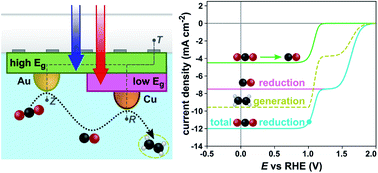Design principles of tandem cascade photoelectrochemical devices†
Abstract
Cascade photoelectrocatalysis (PEC) is a possible method to improve the selectivity of solar-driven CO2 reduction (CO2R). This concept can be realized by coupling different CO2R catalysts to different subcells in a multijunction photovoltaic (PV) stack. Efficient implementation will require careful tuning of the photocurrents and design of the photovoltages provided by the subcells to the CO2R catalysts in such a way as to facilitate the target reaction. Here, we outline the design principles of the tandem PEC approach using two-step conversion of CO2 to ethylene in aqueous electrolyte, via a CO intermediate, as a model system. To perform this reaction, the first coupled PV-catalyst component should provide 4 electrons to reduce 2 molecules of CO2 to CO; the second component should provide 8 electrons to reduce 2 CO molecules to C2H4. Based on known CO2R catalysts, the overpotential required to produce CO can be less than that required to reduce it to ethylene, creating the opportunity for improved efficiency. Cascade PEC can be realized in a three-terminal tandem (3TT) configuration using III–V-semiconductor based subcells coupled to Au (produces CO intermediate) and Cu (converts CO to ethylene). The current to each catalyst can be controlled by the area of the subcell exposed to the electrolyte, and the photovoltage is determined by the materials selected and device configuration. Operating conditions are found by simulating the coupled system using the open-source circuit simulator SPICE (Simulation Program with Integrated Circuits Emphasis). We identify conditions under which a 3TT configuration can have a higher solar to chemical conversion efficiency compared to a two-terminal two-junction tandem (2T 2J) with the same absorbers and a Cu catalyst only. We also show that 3TT PEC devices can be less sensitive to variations in catalyst activity compared to 2T devices. Finally, we discuss the applications of cascade PEC to CO2 reduction, using different intermediates, and to other chemical networks.



 Please wait while we load your content...
Please wait while we load your content...